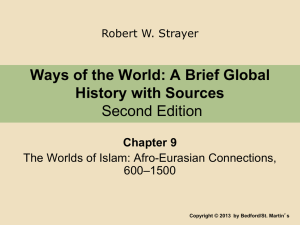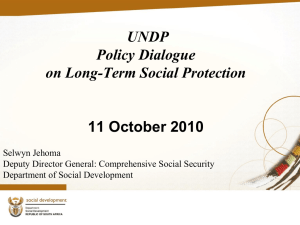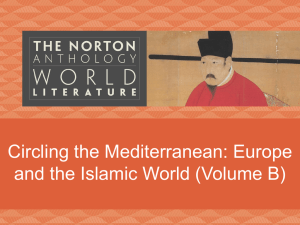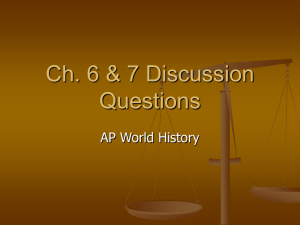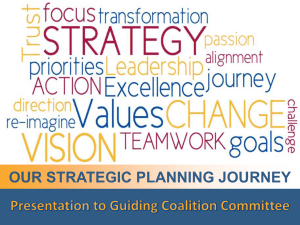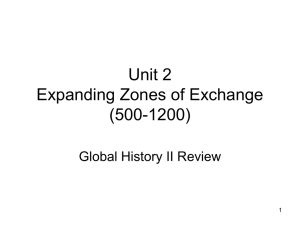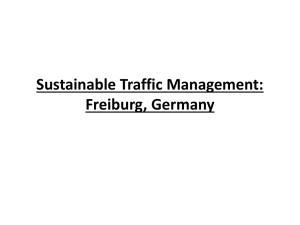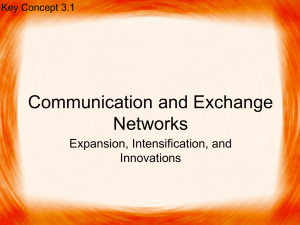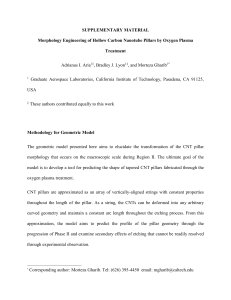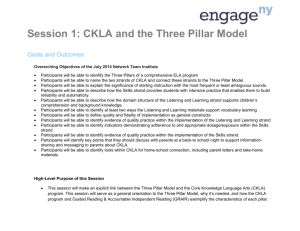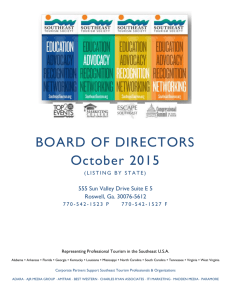Name: NWC Mid-Term Study Guide I. Introductory Unit The Five
advertisement
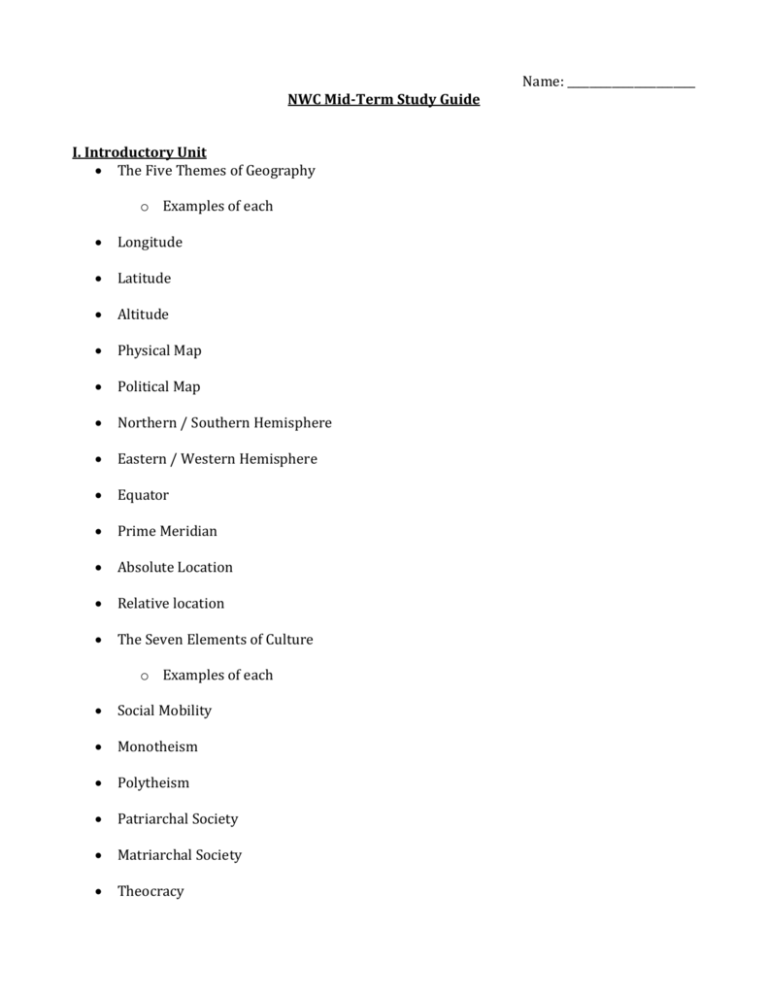
NWC Mid-Term Study Guide I. Introductory Unit The Five Themes of Geography o Examples of each Longitude Latitude Altitude Physical Map Political Map Northern / Southern Hemisphere Eastern / Western Hemisphere Equator Prime Meridian Absolute Location Relative location The Seven Elements of Culture o Examples of each Social Mobility Monotheism Polytheism Patriarchal Society Matriarchal Society Theocracy Name: _______________________ Democracy Republic Dictatorship Traditional Economy Market Economy Command Economy Mixed Economy Characteristics of a developed (Industrialized) country Characteristics of a developing country Imperialism Neolithic Agricultural Revolution Industrial Revolution Nomadic Lifestyle Sedentary Lifestyle Economic Specialization Ethnocentrism Racism Discrimination Prejudice II. Middle East Unit 5 Pillars of Islam Abbassid Empire Abraham Abrahamic Religions Abu Bakr Ahmadinejad Ali ibn Aib Talib Arabesque Arabic (Language) Arab-Israeli conflict Ayatollah Khomeini Balfour Declaration Bashar al-Assad Belief (Pillar) Burka Caliph Charity (Pillar) Christianity Fasting (Pillar) Headscarf Hijab Holocaust Idolatry Illiteracy / Literacy Iranian Hostage Crisis Islam Islamic Fundamentalism Israeli / Palestinian Conflict Jerusalem Judaism Kaaba Koran Matriarchal / Patriarchal Mecca Middle East / Southwest Asia Minarets Mongols Monotheism Mosque Muhammad Occupied territory Ottoman Empire Persian (Language) – Where? Pilgrimage to Mecca (Hajj) (Pillar) Prayer (Pillar) Ramadan Safavid Empire Secular Shi’ite Six Days War Strait of Hormuz Suez Canal Sunni Tarof Theocracy Torah Umayyad Empire Zionism Approximate Dates for: -beginning of Judaism -beginning of Christianity -beginning of Islam Be able to explain: a. b. c. d. e. f. g. Why there are no drawings of Muhammad in Islamic Art. The life of Muhammad How the three main religions which originated in the Middle East are connected. How the Islamic Empire spread. The chronology of the Islamic Empires. How the Five Pillars of Islam affect the everyday lives of Muslims. Why and how the Sunni and Shi’ite groups split III. Africa Unit The Age of Exploration Bartolomeu Dias Christopher Columbus History of Slavery in Africa African Views of Land Ownership Consumer Culture Slave Trade Middle Passage Triangular Slave Trade Raw Materials Manufactured Goods Impact of Slave Trade on Africa Imperialism Dr. Livingstone H.M. Stanley Relative Power Moral Justification “White Man’s Burden” Rudyard Kipling “The Light of Civilization” Berlin Conference Real Occupation Scramble for Africa Nationalism Pan-Africanism Marcus Garvey W.E.B. DuBois Apartheid First African Country to Gain Independence Political Instability Coup d’etat Border Disputes in Africa AIDS in Africa African Union (Objectives) How did the Age of Exploration and Consumer Culture lead to the Slave Trade? Know the effects of the following on the independence movement in Africa: o World War I o World War II o Cold War Why is Africa dependent on foreign aid? How does this affect the continent? How has the history of European involvement in Africa led to Africa’s current problems? What problems does Africa face today? What are some “reasons for hope” for Africa? Index “The Light of Civilization” “White Man’s Burden” 5 Pillars of Islam Abbassid Empire Abraham Abrahamic Religions Absolute Location Abu Bakr African Union (Objectives) African Views of Land Ownership Ahmadinejad AIDS in Africa Ali ibn Aib Talib Altitude Apartheid Arab-Israeli conflict Arabesque Arabic (Language) Ayatollah Khomeini Balfour Declaration Bartolomeu Dias Bashar al-Assad Belief (Pillar) Berlin Conference Border Disputes in Africa Burka Caliph Characteristics of a developed (Industrialized) country Characteristics of a developing country Charity (Pillar) Christianity Christopher Columbus Command Economy Consumer Culture Coup d’etat Democracy Dictatorship Discrimination Dr. Livingstone Eastern / Western Hemisphere Economic Specialization Equator Ethnocentrism Fasting (Pillar) First African Country to Gain Independence H.M. Stanley Headscarf Hijab History of Slavery in Africa Holocaust Idolatry Illiteracy / Literacy Impact of Slave Trade on Africa Imperialism Imperialism Industrial Revolution Iranian Hostage Crisis Islam Islamic Fundamentalism Israeli / Palestinian Conflict Jerusalem Judaism Kaaba Koran Latitude Longitude Manufactured Goods Marcus Garvey Market Economy Matriarchal / Patriarchal Matriarchal Society Mecca Middle East / Southwest Asia Middle Passage Minarets Mixed Economy Mongols Monotheism Moral Justification Mosque Muhammad Nationalism Neolithic Agricultural Revolution Nomadic Lifestyle Northern / Southern Hemisphere Occupied territory Ottoman Empire Pan-Africanism Patriarchal Society Persian (Language) Physical Map Pilgrimage to Mecca (Pillar) Political Instability Political Map Polytheism Prayer (Pillar) Prejudice Prime Meridian Racism Ramadan Raw Materials Real Occupation Relative location Relative Power Republic Rudyard Kipling Safavid Empire Scramble for Africa Secular Sedentary Lifestyle Shi’ite Six Days War Slave Trade Social Mobility Strait of Hormuz Suez Canal Sunni Tarof The Age of Exploration The Seven Elements of Culture Theocracy Theocracy Torah Traditional Economy Triangular Slave Trade Umayyad Empire W.E.B. DuBois Zionism ***The Index contains terms only. Be sure to review questions and concepts found throughout the study guide. (All italicized)

